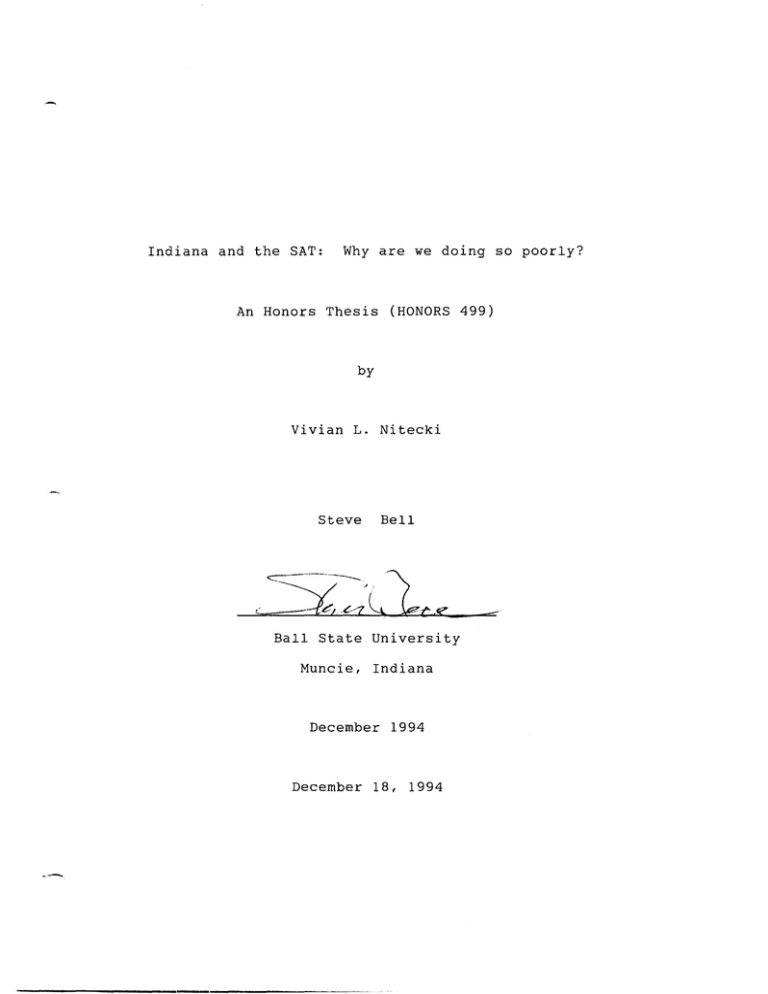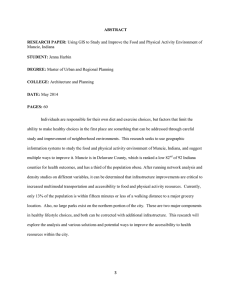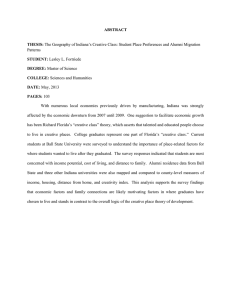Indiana and the SAT: by
advertisement

Indiana and the SAT: Why are we doing so poorly? An Honors Thesis (HONORS 499) by Vivian L. Nitecki Steve Bell Ball State University Muncie, Indiana December 1994 December 18, 1994 · .'~ Purpose of Thesis This video feature documentary It story. package and i sn I t is involves qui te similar more long to work enough a than to be news a an magazine typical entire news thirty minute show. An interview studied SAT Indiana A Ball Muncie Central claims. scores a and consistently States. Indiana wi th I S Wawasee school rank, scores State guidance in board uncovers the Educational counselor surprising bottom 1/5 Psychology provide poor performance rebutting the member, of who has results. the professor Uni ted and a possible reasons for school board member I s October An appeared article Professor on Muncie my and sounded the like documentary or news magazine in had done was and about to the rest of some excellent an September It compared SAT piece. star attention. One man in the article the country. topic to it performance Indiana's poor the brought Bell the in research on source for a We agreed to pursue two of the sources listed in the article for my Honors Thesis. November After contacting member Mike Smith, the he main source, Wawasee school board was gracious enough to stop by campus for an interview while he was on a business trip to Muncie. When he arrived information on he his brought study. important statistics and informa t ion I requested. an interest in posi ti ve was his publici ty. wi th him He three provided more than me years worth wi th willing to Smi th was thri lIed that study and he appreciated He has experienced copies of of give me any we had taken the potential for difficulty getting his analyses out because as he puts it, he's a normal guy interested in the welfare of our state's students and their futures. He isn't an educator or statistician and many people won't take him seriously. I could not have asked for a more cooperative interview. We spent about three hours pre-interviewing and and interviewing Mr. Smith. for interview an in-depth setting up I learned many things about set up as well as how to shoot both an and interviewer interviewee very time consuming will only see process!! about 10 minutes one only wi th camera. In the final of all of It was product that a viewers planning and interviewing, etc!! After tracking down the second found that he no longer kept up wi th source his in study the article we and. referred us to Professor Paschal. After interviewing Paschal the tape of the main interview the next source. Then quotes even though the I can I learned that I need to review before get interviews proceeding direct don I t to responses interview to direct take place at the same time. We then just is interviewed SO time consuming administrati ve permission it was very a high school wai ting and frustrating. guidance for counselor. return phone working out schedules. The interview It calls, Honestly, itself was a breeze, the red tape was a pain!! December Then it was of time to write, write, write. the interviews and picking out the use, I story line. Professor had to wri te After Bell, into several it was One of the final time pieces voice on tape then edi ting. interesting video the bites drafts to to sound and record the to bi tes create plenty my puzzle We ran into After viewing all of voice was trouble I wanted a coherent advice and laying trying to from standup. down my to get so we tried using computer generated graphics to cover "bald" spots. From doing time beginning a story or it takes to picked came the to up a few wri ting, for television. I the knew package, but put things tricks of planning I basics learned together on the trade from and even hair, of what much more a larger Steve goes about the scale. Bell clothes into when I it and make up It was a challenging experience full of lessons that I will take with me in my future in television news. = I would like to give special thanks to Steve Bell for the extra time he set aside to help me out and teach me. I would also like to thank all of the people who let me interview them even with very hectic schedules. Finally, special thanks goes to fellow TeOM student Dave Donohue who helped with camera operation and editing. This project would not have existed without the cooperation of all of the people mentioned above. Thank You!! Smith: Indiana stinks. We're at the bottom of the barrel. In apples to apples comparison there aren't many below us. I'd like to see that changed. Vivian: What has this Wawasee school board member upset is the performance of Indiana high school students in a national academic test. High school seniors across the nation prepare for the SAT regularly ... and Indiana students have among the lowest average scores of any state. In 1993 we were 47th out of 50. But is it really that bad? BJ: Indiana ranked 47th out of 50. This is very deceptive.11 People are willing to say and do anything to make educational points using SAT scores. Vivian: Many Indiana educators, including BJ Paschal, a professor of Educational Psychology at Ball State University, believe it is misleading to use SAT scores to evaluate the performance of public schools. Paschal:lf you use class rank, GPA and extracurricular activities you have an even better prediction, but SAT score itself is the best predictor of college performance. Vivian: Defenders of Indiana's student performance also point out that 60 percent of the state's high school seniors take the exam ... one of the highest percentages in the country ... and that can distort results. Paschal: (Explanation of stats on percent that take SAT) Vivian: Guidance counselor Berlin Rowe of Muncie Central High School agrees. Rowe: Our top 5 or 10 would compete with any in the country but since we have even our special education people taking the SAT, that's all taken in the average. Paschal:The trend is very clear. When a large number within a state take the SAT, the lower the scores are. Vivian: But Mike Smith, Wawasee school board member, has done an in-depth study of IN's results on the SAT and says this is no excuse. Over the last three years, Smith has studied SAT scores and rank across the country. To eliminate sample differences, he compared Indiana students with other states according to class rank. He found that Indiana consistently comes out near the bottom of the list. Even Indiana's top students aren't cutting it. Smith: Compare only the top 10 percent to the top 10 percent in every other state ... // If all the factors are the same, what you find is we are at the bottom of top 10 percent ... bottom across the nation. Vivian: Smith also points out that in NJ and NY there are high participation rates and low ranks, but when the results are broken down by class rank these states move up in SAT ranking ... Indiana doesn't. Smith: There are many states where the participation argument is valid sometimes like NJ and NY. Like class ranks jump ... we seem to deserve that low rank. Vivian: Smith's critics say all the factors in his study aren't the same and his results are slightly flawed. Paschal:These comparisons aren't valid unless you level the playing field and you level it by taking all relevant variables and make them equal statistically. That's what people are not doing like// George Will and// the school board member at Wawasee. Vivian: In an attempt to "level the playing field", Smith gathered background information from students taking achievement tests. They listed what courses they completed or plan to take. He found that Indiana's rank coincides with how many challenging or advanced classes a student takes. Smith: The problem in Indiana is our students aren't working hard. Our students take far less core curriculum. We rank 48th in core studies ... I believe the two are directly correlative. (Edit out listing) Rowe: As counselors we try to encourage the students to take more difficult courses and we're in this situation right now for the seniors. We're t the end of the first semester and they're already thinking about dropping some of the classes such as Calculus or maybe a Physics class second semester. They want to have it a little easier, so we really fight that and discourage it.// We try to convey this message to them, and some of them pay attention and some don't. Vivian: Smith says high school students have too many options when it comes to choosing classes that are less challenging and Paschal agrees. Parents aren't involved enough in the selection of classes and students tend to take the path of least resistance. Indiana's new "Core 40" is an effort by the state to toughen standards for high school students. Not everyone believes this will have positive results. Rowe: This putting in specific requirements of more math, more science, more English, more social studies. All of these kinds of things and we're concerned if we're going to have more drop outs if we bring such stringent requirements on the students. We have a lot of drop outs now, will this force more to drop out? Hopefully, it won't but this is our concern at the present time. Smith: To learn the latest ... blue collar jobs decrease Indiana will be in deep trouble.(15:55) I think we'll see ... is at stake. (15:20) In my mind education translates to liberty. What uneducated electorate can sustain liberty very long?// An educated electorate is key to keeping freedom in USA.




